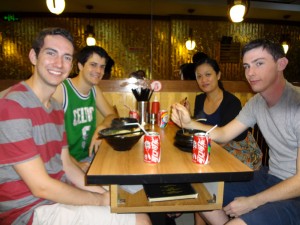If you’re reading this, that means you’re still interested in going to Shanghai–and that I haven’t scared you away, yet. Now that you can say hello and goodbye, you’re probably pretty proud of yourself. Those are important words, but there are some others that might help make your transition a little simpler. Food and transportation are two things that you are going to have to deal with, regardless of what you’re doing in China or how long you are staying. The food you’re used to (name brands, cheese, frozen food) are available in China, but you’ll be amazed how expensive they can be! If it’s imported, it’ll cost you an arm and a leg. If you really, really want that bag of potato chips or frozen dinner, you can get it at a Western grocery store (such as City Shop or Tesco, both popular chains in Shanghai).
But for those who don’t want to spend $10 for a pack of noodles to keep in the freezer, you can either buy Chinese brands (which you have to guess what’s in it–intuition tells you what it should be, but the label and packaging is entirely in Chinese!) or you can spend a lot of your time eating out. Without a car, buying bags of groceries is not as good of an idea as it is back home–remember, you have to carry those bags all the way to your housing, and Shanghai can be oppressively hot! Just make sure your groceries have a logo with a white S over a blue background–that’s the Chinese seal of quality.
For me, it made more sense to eat out. It’s a little more expensive than cooking for yourself, but the food in Shanghai is tasty and a social event. If you’re in China with a group, I’ve found that food is the best way to make friendships and talk to new people. Shanghai has an entire range of food types, but know that they’re probably not the same as the ones you’re used to back home. They have American food, Italian food, and Mexican food, but it all has a bit of a Chinese flair. You’ll get used to it–and miss it as soon as you get home from your trip!
An important topic is Chinese eating etiquette, which means (you guessed it!) chopsticks. They’re devilishly tricky if you’ve never used them before, but you’ll learn quickly… it’s either that or you’ll be hungry for the first couple of days! I can’t explain how to use chopsticks on here, it’s something you have to try for yourself. I suggest practicing before you get to China in order to avoid unwanted chuckling at your expense! As soon as you do learn how to use chopsticks, there are some things you need to know about them. First of all, do not stick your chopsticks directly into a pile of rice and leave them there–that’s offensive because it resembles burning funeral incense. A lot of Chinese restaurants serve their food family style, in which you have a large number of different dishes you share with the rest of the table. This gives you a great opportunity to taste a bunch of dishes you would have never thought to try before. Take what you want, but remember the rest of the table wants to eat, too! Although in America we assume Chinese food usually includes rice, it is important to know that rice and noodles are considered “poor man’s food”–cheaper staple foods that fill you up quickly. Therefore, restaurants or families will serve the more expensive, elaborate, and ornate meat dishes first. Noodles or rice are usually served last to fill you up if you still have room.
Now that you know all of that, it’s time for you to learn some vocabulary! Before you know it, you’ll be eating like a pro.
|
PIN YIN |
ENGLISH PRONUNCIATION |
MEANING |
|
Fandian |
Faun Dee-on |
Restaurant |
|
Mifan |
Me Faun |
Rice |
|
Miantiao |
Me-on Tee-ow |
Noodles |
|
Fuwuyuan |
Foo-oo-yoo-wan |
Waiter/Waitress |
|
Maidan |
My-don |
Bill |
|
Qing |
Ching |
Please |
|
Bu Yao |
Boo Yow |
I Do Not Want |
|
Mei You |
May Yo |
I Do Not Have |
|
Shui |
Shway |
Water |
|
Bing |
Bing |
Ice |
|
Tang |
Tong |
Sugar |
|
Shuiguo |
Shway Gwo |
Fruit |
